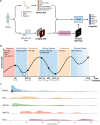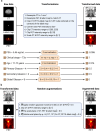Multi-task Bayesian model combining FDG-PET/CT imaging and clinical data for interpretable high-grade prostate cancer prognosis
- PMID: 39505979
- PMCID: PMC11541986
- DOI: 10.1038/s41598-024-77498-0
Multi-task Bayesian model combining FDG-PET/CT imaging and clinical data for interpretable high-grade prostate cancer prognosis
Abstract
We propose a fully automatic multi-task Bayesian model, named Bayesian Sequential Network (BSN), for predicting high-grade (Gleason 8) prostate cancer (PCa) prognosis using pre-prostatectomy FDG-PET/CT images and clinical data. BSN performs one classification task and five survival tasks: predicting lymph node invasion (LNI), biochemical recurrence-free survival (BCR-FS), metastasis-free survival, definitive androgen deprivation therapy-free survival, castration-resistant PCa-free survival, and PCa-specific survival (PCSS). Experiments are conducted using a dataset of 295 patients. BSN outperforms widely used nomograms on all tasks except PCSS, leveraging multi-task learning and imaging data. BSN also provides automated prostate segmentation, uncertainty quantification, personalized feature-based explanations, and introduces dynamic predictions, a novel approach that relies on short-term outcomes to refine long-term prognosis. Overall, BSN shows great promise in its ability to exploit imaging and clinicopathological data to predict poor outcome patients that need treatment intensification with loco-regional or systemic adjuvant therapy for high-risk PCa.
Keywords: Bayesian; FDG-PET/CT; Multi-modal; Multi-task; Prognosis; Prostate cancer; Segmentation.
© 2024. The Author(s).
Conflict of interest statement
The authors declare no competing interests.
Figures









Similar articles
-
Increased Prostate Cancer Glucose Metabolism Detected by 18F-fluorodeoxyglucose Positron Emission Tomography/Computed Tomography in Localised Gleason 8-10 Prostate Cancers Identifies Very High-risk Patients for Early Recurrence and Resistance to Castration.Eur Urol Focus. 2019 Nov;5(6):998-1006. doi: 10.1016/j.euf.2018.03.008. Epub 2018 Mar 30. Eur Urol Focus. 2019. PMID: 29609897
-
More advantages in detecting bone and soft tissue metastases from prostate cancer using 18F-PSMA PET/CT.Hell J Nucl Med. 2019 Jan-Apr;22(1):6-9. doi: 10.1967/s002449910952. Epub 2019 Mar 7. Hell J Nucl Med. 2019. PMID: 30843003
-
GLUT1 expression in high-risk prostate cancer: correlation with 18F-FDG-PET/CT and clinical outcome.Prostate Cancer Prostatic Dis. 2020 Sep;23(3):441-448. doi: 10.1038/s41391-020-0202-x. Epub 2020 Jan 13. Prostate Cancer Prostatic Dis. 2020. PMID: 31932660
-
Positron emission tomography for prostate, bladder, and renal cancer.Semin Nucl Med. 2004 Oct;34(4):274-92. doi: 10.1053/j.semnuclmed.2004.06.004. Semin Nucl Med. 2004. PMID: 15493005 Review.
-
Management of positive lymph nodes following radical prostatectomy.Arch Esp Urol. 2019 Mar;72(2):182-191. Arch Esp Urol. 2019. PMID: 30855020 Review. English.
References
-
- Siegel, R. L., Giaquinto, A. N. & Jemal, A. Cancer statistics, 2024. CA A Cancer J. Clin.74, 12–49 (2024). - PubMed
-
- Wilt, T. J. et al. Systematic review: Comparative effectiveness and harms of treatments for clinically localized prostate cancer. Ann. Intern. Med.148, 435–448 (2008). - PubMed
-
- Jeffrey Albaugh, M. Measurement of quality of life in men with prostate cancer. Clin. J. Oncol. Nurs.12, 81 (2008). - PubMed
-
- Sanda, M. G. et al. Quality of life and satisfaction with outcome among prostate-cancer survivors. N. Engl. J. Med.358, 1250–1261 (2008). - PubMed
-
- Shariat, S. F., Karakiewicz, P. I., Suardi, N. & Kattan, M. W. Comparison of nomograms with other methods for predicting outcomes in prostate cancer: A critical analysis of the literature. Clin. Cancer Res.14, 4400–4407 (2008). - PubMed
MeSH terms
Substances
LinkOut - more resources
Full Text Sources
Medical

